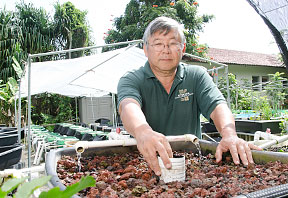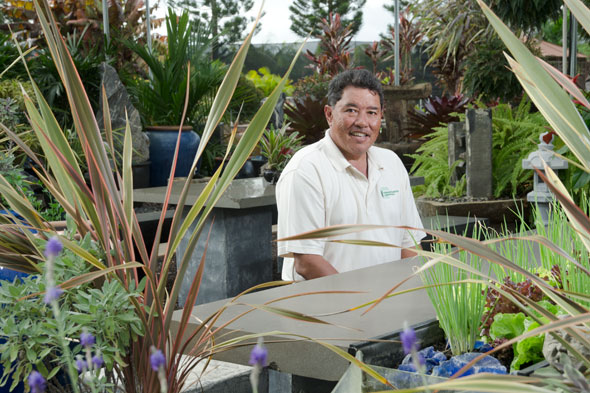Aquaponic systems grow food sustainably
April 18th, 2011 | by Cheryl Ernst | Published in April 2011, Multimedia | 14 Comments
Web extra: Introduction to Home Aquaponics
Clyde Tamaru stands on a small rise, dense trees and the verdant Windward face of the Koʻolau range behind. He looks across a grassy area dotted with round water tanks of various construction, rows of raised plant beds, a small garden shed and, off to the right, a taro loi, all part of an aquaponics research and demonstration facility tucked at the back of Windward Community College.
“This is our ahupuaʻa,” the University of Hawaiʻi at Mānoa College of Tropical Agriculture and Human Resources extension specialist says with evident pleasure.
The Hawaiian mountain-to-sea land division—and the sustainable ecosystem of food resources that it represents—is modeled here in an area perhaps half the size of a football field. CTAHR staff has use of the grounds in exchange for teaching a Windward course.
Aquaponics combines aquaculture (raising aquatic animals) with hydroponics, (growing plants in water). Tamaru’s goal is to develop a modern closed, self-sustaining system that can produce food independent of imported feed, fertilizer and energy. His mantra: “Pretend the boat never comes,” a reference to Hawaiʻi’s dependence on shipped goods.

Tamaru at his Windward Community College research facilities
Behind Tamaru, several conical gray plastic containers are set on poles in the ground, looking like odd knee-high mushrooms. Inside, soldier fly larvae chomp through piles of an invasive species of tilapia removed from a nearby lake. They’ll dine on cafeteria waste with equal fervor.
When sated, mature grubs crawl up a ramp and fall into a collection bin, ready-to-serve fish food for the fish being cultured—ironically, a commercial variety of tilapia. Tamaru keeps brood stock of three varieties in a half-dozen round aboveground tanks ranging from plastic-lined home-built forms to prefabricated models. Some of the occupants move to smaller tanks that are part of the aquaponic system.
Water from the fish tank is pumped through filters—where bacteria convert the ammonia from the fish waste into nitrates, which plants need—and into the plant beds. In some beds, lettuce grows in plugs suspended from foam sheets that float on the water’s surface. In others, a variety of plants grow from a cinder bed as water alternately rises to the root line and drains, now clean, back to the fish tank.
Green waste from unused plants is composted in the Waikīkī Worm Company’s half-barrel worm bins nearby. “A mix of the vermicast casings with chicken or turkey manure contains all the micronutrients plants need to grow—potassium, iron, manganese, phosphate, calcium,” Tamaru says. Blended with peat moss or coconut coir, it makes an ideal organic medium for growing seedlings.
“Give credit to those red worms, I tell you!” Tamaru chuckles. “That’s one big part of the puzzle solved.”
A remaining piece is the energy required to run the bilge pump that moves the water. “That’s the big bottleneck,” he says. He uses solar panels. They have a 30-year lifespan, but they are pricey and still require imported materials.
“Solar is good, but it has limits. It takes two 3- by 5-foot panels to run one bilge pump.”
For Fred Lau, a landscape contractor who has dedicated one acre at his Mililani nursery to a commercial aquaponics venture, the photovoltaic investment alone represents a $150,000 cost.
So why pursue the project?

Manoa lettuce thrives in an aquaponic grow bed at Mari's Gardens.
“This is definitely the most sustainable way of farming I know of,” he says. “We can’t keep doing things the conventional way.” Particularly in the face of the rising fuel charges on food and materials shipped to the islands.
Long interested in water conserving landscape practices, Lau saw aquaculture as a way to get a second use of the water running to the plants at Mari’s Gardens, his 18-acre nursery. He met Tamaru while “scavenging” for fish fry.
“He’s the only person who really helped us,” coming by on weekends and bringing in other experts from the College of Tropical Agriculture and state Department of Agriculture.
Lau was able to get some grant funding to help set up the prototype and test plant varieties.
“I’m growing everything I like to eat—Mānoa lettuce, heirloom tomatoes, Japanese cucumber, green onions, Chinese parsley and beets, a bunch of different kinds.”
The early question of whether aquaponic crops would taste fishy was soon put to rest, he says. The continuing question is economic viability. Lau sells to health food stores and at some farmers markets. He’s looking at a likely two-year return on investment.
“For me, that’s a little slow, but I hear two to three years is typical.”
Aquaponics can also be a human investment.
Tamaru works with staff at the Hawaiʻi State Hospital next door who adopted aquaponics as part of their occupational therapy work program. About a year ago, staff members and patients assembled three aquaponic modules on an old, outdoor basketball court. Each consists of a fish tank, a cinder bed filter and two floating rafts, all supported on tables.
“It was like building an erector set,” says occupational therapist Judy Dacanay.
Patients in the work program learn important skills—being on time, collaborating, accepting direction—while maintaining the system. It helped that one patient was a plumber. Each Tuesday, they harvest about 5–15 pounds of lettuce and green onions, which goes into salads and sandwiches served at the facility.
Tamaru is also working with the state Department of Hawaiian Home Lands on its Waiʻanae Valley homestead project and Godʻs Country Waimānalo Homestead Association.
The Kaupuni project in Waiʻanae incorporates an aquaponic system on each homestead to provide food for the families. “Similar goals of becoming more self reliant in the availability of food are being sought in Wamānalo,” he says. “What doesn’t grow in sand, aquaponics can do.”
It’s another demand on his and his colleagues’ time, but Tamaru’s enthusiasm doesn’t wane.
“That’s what we do. We’re land grant extension agents and specialists,” he explains, referring to agricultural mission set at the university’s founding.
Learn more: search for “aquaponics” at the CTAHR website for free, downloadable publications.
Introduction to Home Aquaponics
To learn more about home aquaponics, the Mālamalama magazine team visited University of Hawaiʻi Aquaponics Specialist Clyde Tamaru at his outdoor facility on the grounds of Windward Community College.
Tags: agriculture, aquaculture, College of Tropical Agriculture and Human Resources, sustainability, UH Manoa, Vol. 36 No. 2


April 28th, 2011at 5:43 am(#)
Awesome.
I have seen all those locations in person and I am completely mesmerized and impressed.
It’s impossible to come away from talking to Mr. Lau and Mr. Tamaru and not want to join in on the future of Hawaii, and the world.
They love to teach, and they love to share. Making the world a better place.
Aloha.
April 28th, 2011at 7:30 am(#)
Have you visited my cousin Graf Shintaku at his farm in Windward Oahu? He’s one of (if not the original)Hydroponics farmers in Hawaii, a graduate of Cal Poly, San Luis Obispo, CA., and started hydroponic farming back in the late “50′s.
April 28th, 2011at 10:55 am(#)
Aquaponics – YES! For the past two years the elementary students at the University Laboratory School have been working with their own aquaponics systems including a vertacle tower added this year. This is part of their extensive Learning Landscape Sustainable Garden project that emphasizes sustainable options for growing food and resource use. They welcome visitors anytime! Student docents love to share their knowledge and accomplishments. Please contact me if you would like to stop by. laurie_faure@universitylaboratoryschool.org
April 28th, 2011at 7:22 pm(#)
I run a local website dedicated to sharing information about aquaponics. You can find it at:
http://aquaponicsinparadise.com/APforums/index.php
Its got over 600 members who are sharing pictures of their systems, how they built it, where to get materials, etc.
April 29th, 2011at 1:49 am(#)
Are visitors welcomed? If so, when is the best time w/o imposing on your work? I am curious as to where you acquired the stands for your plastic bins?
Gordon
April 29th, 2011at 7:51 pm(#)
Aloha,
I’m very interested in starting an aquaponic garden, may I come to see yours, Mr. Tamaru?
I would like to start this soon. [Phone number redacted]
Mahalo,
Lesley
May 1st, 2011at 6:23 am(#)
We have 11+ acres in Kahaluu fronting Kamehameha Hwy. and would like to provide an interested party with the opportunity to establish a farm.
May 2nd, 2011at 11:33 am(#)
@donald funai
your cousin is doing HYDROponics. This is about AQUAponics.
Do you understand the difference?
@michael chun
aquaponics and natural farming? We have been looking at farmland for some time. How do I contact you?
May 3rd, 2011at 3:17 pm(#)
This is great sharing with basic about aquaponics. I know that there are great research and application on aquaponics in Hawaii, and look forward better future on application over aquaponics systems. Feel free to check out the site about how to aquaponics at http://www.squidoo.com/aquaponics-4-you-how-to-aquaponics-indoor-growing-system
June 13th, 2011at 6:46 pm(#)
Wow, really informative information you have provided. Thanks for posting this. I saw in the caption of the photos that the girl was giving a tour… Are there public tours available and where can I find more information on them?
Thanks
August 20th, 2011at 7:28 am(#)
You information is what I have been looking for, Short, Sweet, and to the point. A.Before I do this I’d like to know does it smell bad? There is fish waste involved so the potential is there. B. What types of treatment can prevent or remove algae bloom.
August 22nd, 2011at 11:41 am(#)
I was wanting to get a hole of the dr. Tamaru’s i am want to start grow produce agen. am looking at putting up some aquaponic greenhouse here in oklahoma and want to know all i could before i start to put all of them up. you can email at coburng@student.swosu.edu
any help would would be nice
thanks you:
Grady Coburn
December 21st, 2011at 8:13 pm(#)
We have a 100 acre parcel in the north shore and are looking to do a large scale aquaponics system. Looking for qualified help. Please email at
dylan@alohagreen.com
February 1st, 2012at 5:50 am(#)
Such great information here and photos! You make me want to book a flight immediately so I can see all the Hawaiian aquaponics wonders first hand. Someday soon :) Thanks again!